2018 is rapidly approaching and, from what I can tell, things are about to change BIG TIME on the SEO front.
Today, I’m here to walk you through what’s making waves in the SEO world in 2018 as well as give you practical tips and techniques you can implement right away to make sure you stay ahead of the competition!
Here’s what we’re going to cover in this article:
- How to Think about Google’s RankBrain
- Google’s Going Mobile-first
- Speaking of Voice Search
- Tuning-In to Video
- Content and Links Still Rule
Buckle in because I’m about to take you on a fascinating tour of what to expect for SEO in 2018.
How to think about Google’s RankBrain
Google’s RankBrain was first introduced in 2015.
Around that time, RankBrain handled about 15% of the 3.5 billion search queries Google receives daily.
Today, RankBrain is involved in every search query and has been revealed as the third-most important ranking factor in Google’s vaunted ranking algorithm, next to links and content (more on that later).
It is also designed to match never-before-seen search queries to their best answers by predicting the best possible match.
How does RankBrain work?
In short: RankBrain interprets either positive or negative user signals based on how people interact with its search results. It uses those user signals to predict with better accuracy the search result that is most likely to provide the best search experience to its users.
Here’s a demonstration of how it works:
Suppose you do a search for ‘best electric cars’:
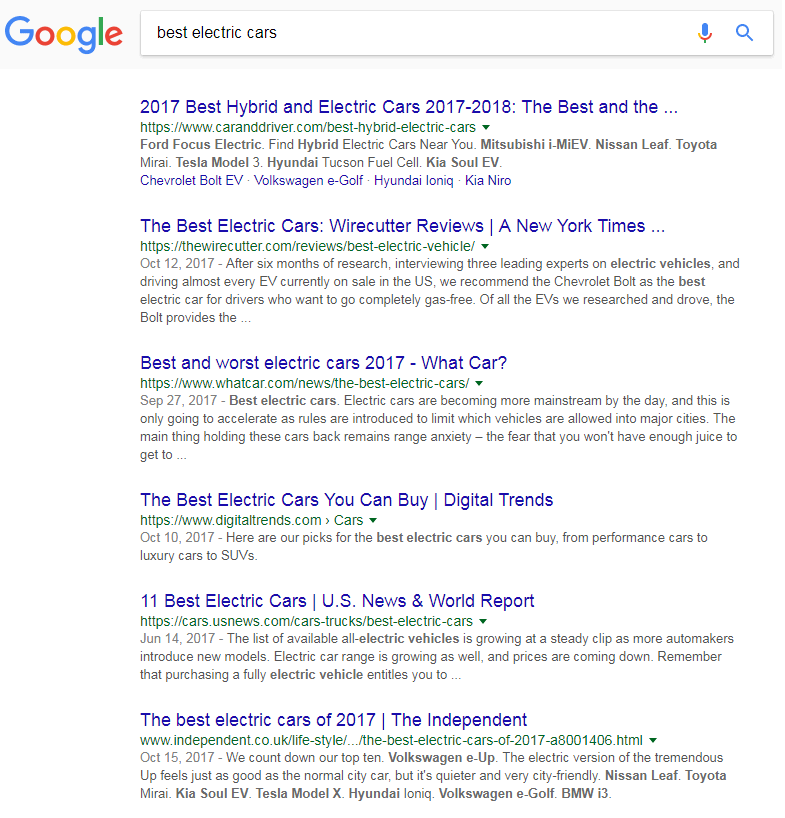
The first result looks particularly enticing so you click on that one.
When you get there, however, you are bombarded with annoying pop-ups and embedded advertiser videos that start playing somewhere outside of the viewport. You quickly find yourself feeling overwhelmed and hit the ‘back’ button on your browser.
RankBrain is going to look at that interaction, one in which the first result was clicked on, the searcher stayed on the page for about 10 seconds, then hit the back button. It will likely draw the conclusion that that search result wasn’t a good pick for the search query ‘best electric cars’ and might not keep it at the #1 spot as readily anymore.
In contrast, suppose I click on the third result and love what I find: instead of bouncing after 10 seconds, I end up reading all 1,500 hundred words on the page.
In that case, RankBrain will also take note and will likely give the #3 result a boost in the rankings.
How to Optimize for RankBrain
RankBrain learns from how people interact with search results, mainly through two user interaction signals:
- The percentage of people who click on a search result (Click-Through Rate or CTR)
- The amount of time a user spends on the page (Dwell Time)
Let’s take a closer look at those two factors now:
RankBrain and Click-Through-Rate
In my post 5 Ways to Improve your Google Ranking in 2017, I spoke about Click-Through-Rate as being an increasingly important factor towards improved rankings.
In 2018, this becomes even more critical!
Here’s why:
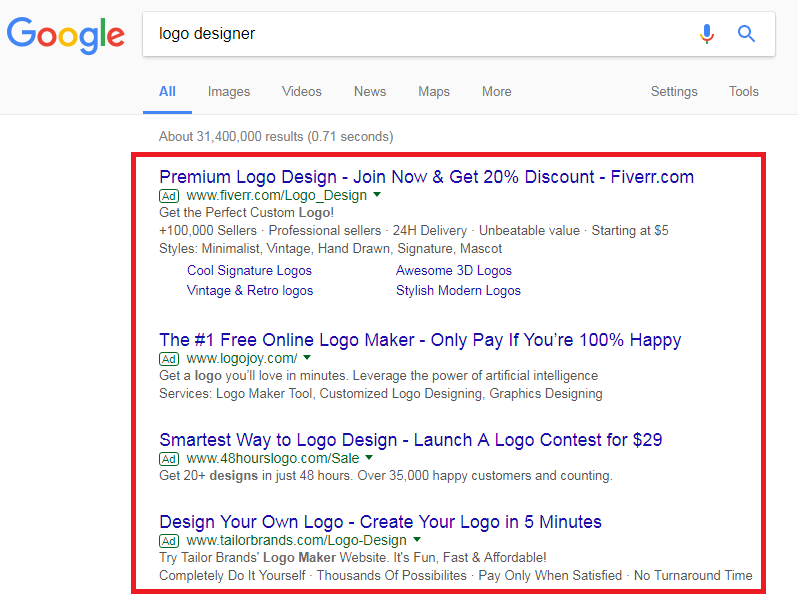
And:
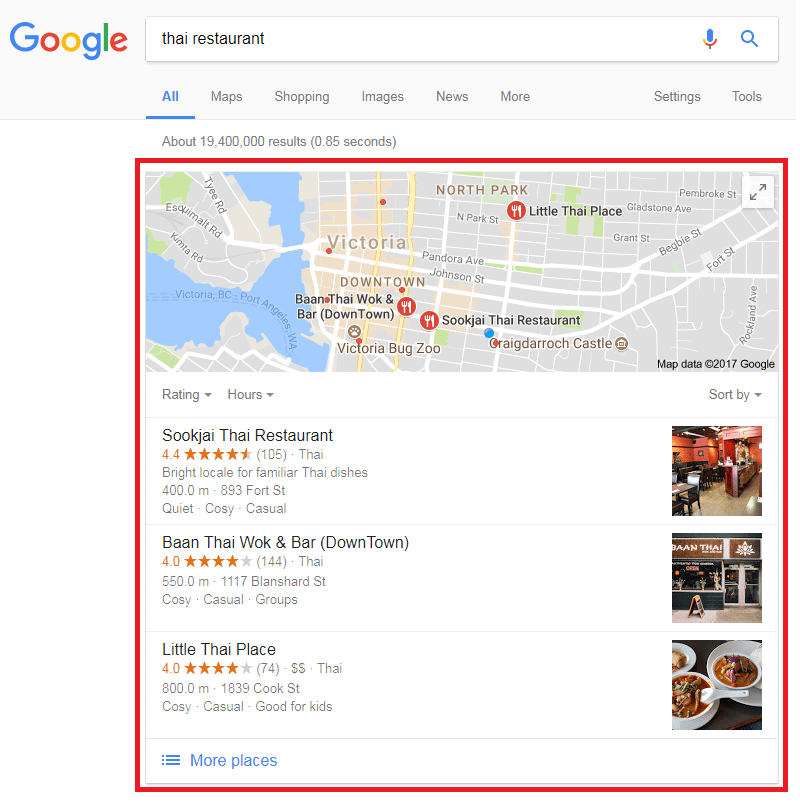
As well as:

And even:
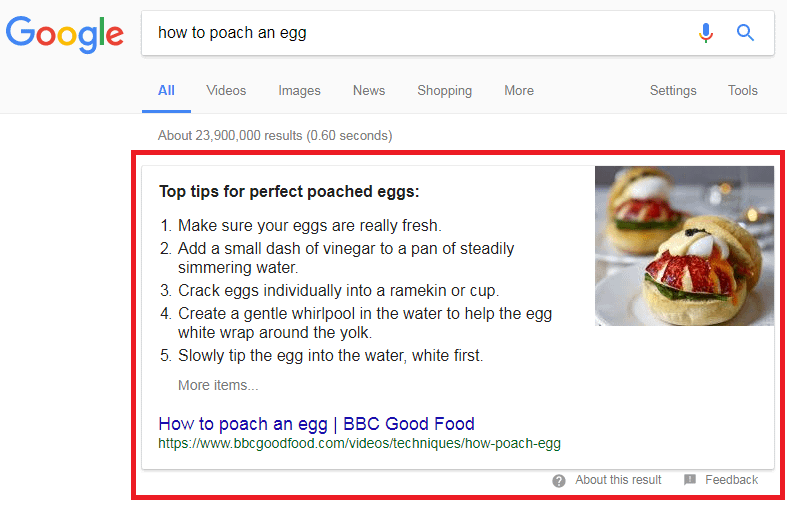
As you can see, there is less and less web real-estate available for organic search results.
This is especially true for Local SEO as SERP features extend to promote local businesses.
Google and other search engines are doing a great job at answering our queries quickly but, in the process, are crowding out organic search results with ads, answer boxes, multimedia carousels, and other SERP features.
In fact, a recent study reports that organic click-through is down 37% from two years ago – that’s a lot!

How to Optimize Click-Through Rate in 2018
For starters, avoid targeting keywords that generate SERP features like Answer Boxes, Video results, and Rich Snippets.
To do this, search for your target keyword in Google, Bing, and Yahoo.
Does the search query trigger a lot of these SERP features?
If your keyword is absent from these search engine-generated features, you’re good to go.
If you can’t compromise on your keywords, consider implementing Structured Data onto your site to help encourage your content’s inclusion in one of Google’s SERP features.
For a more detailed look at improving Click-Through-Rate, make sure you check out my post where I cover tips on improving click-through-rate.
RankBrain and Dwell Time
The other factor that RankBrain pays attention to is Dwell Time.
Dwell Time, simply put, is the amount of time someone spends on your page between clicking on your result in the SERPs and clicking the back button.
A longer Dwell Time signals to search engines that people are engaging with your content longer and this correlates to higher rankings. This was covered in more depth in an article by Search Engine Land.
How to Increase Dwell Time on your Website
Generating higher dwell time starts with creating rich, in-depth content around your particular subject.
Aim for around 1,500-2,500 words. In that many words, you should be able to cover the main points of just about any subject.
Include various multimedia like images and videos to pad and support your ideas, and to offer the reader a break from text.
Also, don’t be afraid to link out to other sources to back up your claims and to provide the reader with more information, should they choose to use it.
A diverse linking strategy – both internally and externally – is good for SEO.
Include LSI Keywords
LSI keywords are words that are related contextually and semantically to your primary keyword.
For example, if my primary keyword was ‘Mario Brothers’, some LSI keywords might be:
- Luigi
- Plumber
- Princess Peach
- Video Game
- Nintendo
Including keywords that relate to your primary content has a lot of benefits including:
- Improving your content by covering a broader range of topics (good for increasing dwell time, too!)
- Introducing more related keywords into your content which can produce more long-tail traffic to your website
- Becoming an expert and authority in your niche
How to Find LSI Keywords
Personally, I like to start with good ole’ Google.
Start by typing your keyword into Google:

From there, scan what comes back.
One of the first things you might notice is this:

This handy feature tells us other popular queries that we can use to give us clues about additional LSI keywords (like “Luigi”!).
Another section of the page you’ll want to check is the related searches section at the bottom of the page:
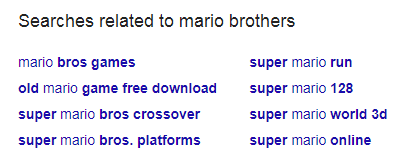
If you want a more streamlined approach to generating and collecting LSI keywords, there’s a free tool called LSI Graph. Simply enter your keyword into the search field:
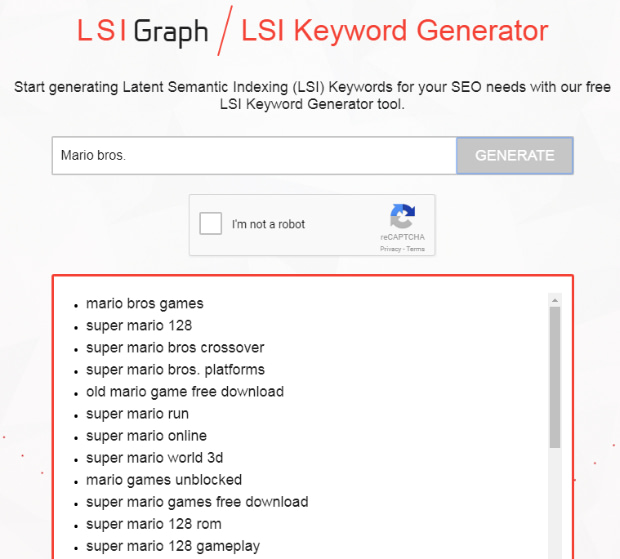
Scan the results for LSI keywords that make sense to include in your content.
Another free tool you can use is Google Keyword Planner.
Select the first tab “Search for new keywords using a phrase, website or category”:
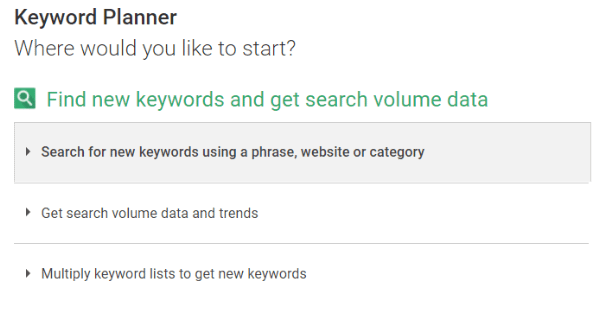
Enter your keyword and click “Get ideas”.
What you’ll get back is a list of some juicy LSI keywords you can use in your content:
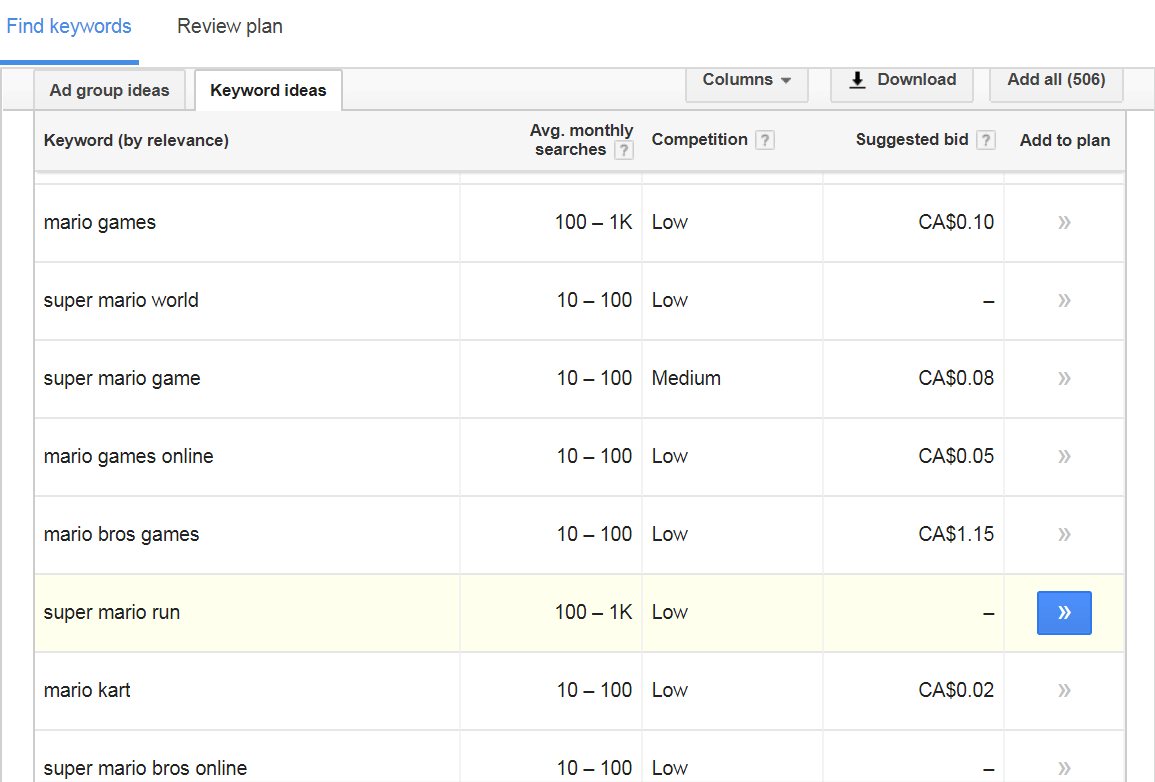
Apart from a list of possible LSI keywords, you can also get a sense of search volume for each of these terms.
The Takeaway:
While learning how to write interesting page titles and meta descriptions will go along way in generating a higher CTR, let’s not forget that the content on the page has to be of quality substance.
It isn’t enough to just get clicks. What you want is for people to stick around on your page.
Take the time to put together good content, make good use of LSI keywords, include different types of multimedia, and first and foremost, keep the end user in mind!
If people aren’t picking up what you’re putting down, you’ll never rise up the ranks.
Of course, knowing what keywords to target and optimizing your On-Page SEO is still important, if you aren’t creating great content, none of that is going to matter.
Google’s Going Mobile-first
Last year, Google announced that it will be moving over from a Desktop-first approach to a Mobile-first approach when it comes to indexing web pages.
Up until recently, Google looked at web pages through the eyes of a desktop user. Now, Google is shifting towards indexing the mobile version of a web page first, and then the desktop version.
This makes a lot of sense as, for the first time ever, mobile searches have surpassed desktop searches worldwide:
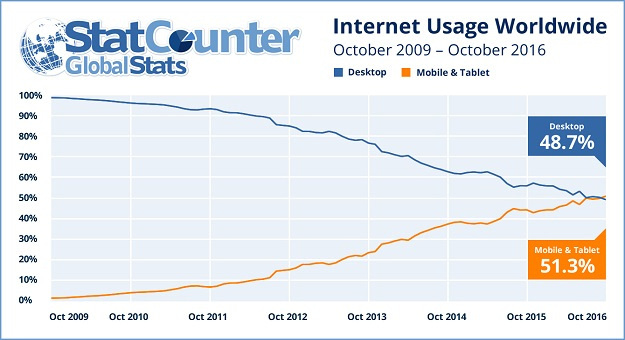
Here’s what that means for you:
From now on, your website will have to be a lot more sensitive to how a search engine experiences it, particularly on mobile.
For example, it’s not uncommon that, on the mobile version of a website, certain content is hidden with CSS or JavaScript.

Another scenario might be a stripped-down mobile website, in the name of saving costly download bandwidth, that loads fewer page assets such as large images or videos.
In any case, it’s important that there is no loss of content between the mobile site and the desktop one. Otherwise, some of your content might not be seen by the search engines and you might experience a slip in your search rankings for those particular pages and overall.
How to Optimize for the Mobile-First Index
If you haven’t already, it’s time to optimize for mobile.
One of the first steps is running your website through the Mobile-Friendly Test.

The next step is to optimize the performance of your mobile website.
To do that, head over to Google’s PageSpeed Insights and plug your web address into the text field. When you do, you’ll get a rating as well as a list of things you can do to optimize page performance:

Aim for better than 80/100 or a green rating:
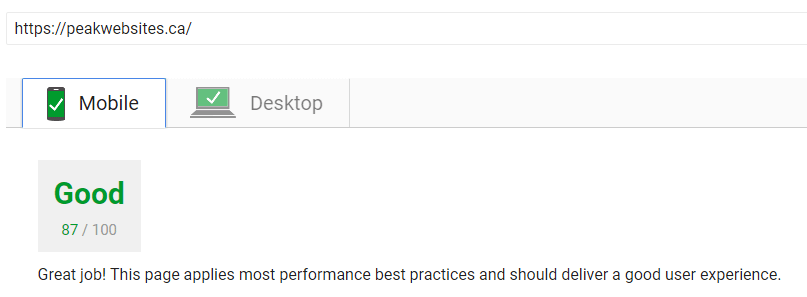
But why is performance so important?
Because people will abandon your site if it takes too long to load.
On top of that, if your website isn’t mobile friendly or easy to navigate on a mobile device, you’ll experience higher bounce rates, shorter dwell times, and subsequently lower rankings (remember RankBrain‘s user signals?).
So make the investment to optimize your website for mobile because Google’s Mobile-first index is going to be standard practice and those that don’t follow suit may get left behind in the SERPs!
Speaking of Voice Search
Voice search is on the rise.
Though I still find it a little weird asking my phone to do things for me (“Set timer 30 minutes”), just look at these statistics:
- Google voice searches are up 35x from 2008 (source)
- 40% of adults use voice search at once a day (source)
- 20% of searches on mobile are Voice searches (source)
With all this upwards momentum, isn’t it important that we optimize our web content accordingly?
Yes and no.
You see, voice searches aren’t the same as web searches.
When you consider that a large percentage of those voice searches are simple, utilitarian tasks (“Ok, Google. What’s on my Calendar today?”).
[Here’s a more comprehensive list of what Google Assistant can do]
On top of that, short-answer questions like questions that return a one-word answer or a number, for example, generate Google-provided Answer Boxes that include no web source.
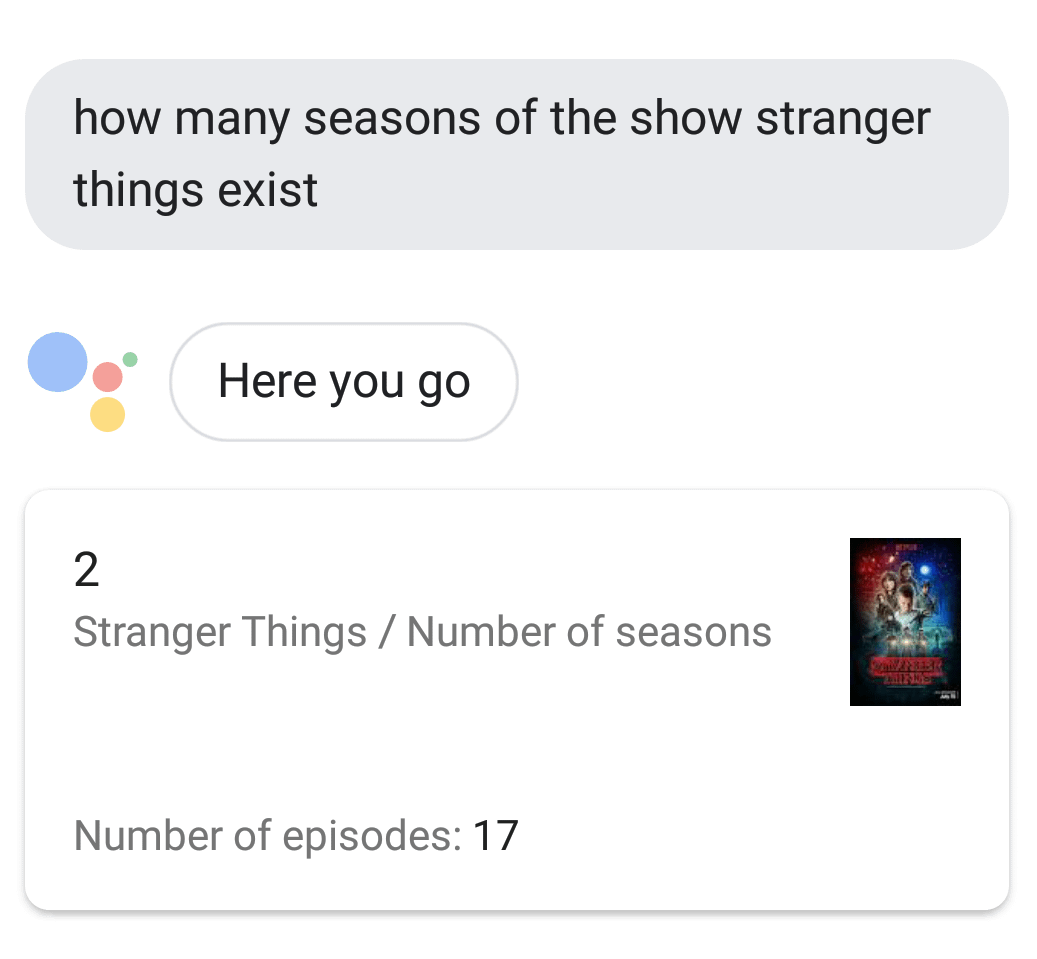
These native answer boxes are likely generated from looking at the most trusted source they can find.
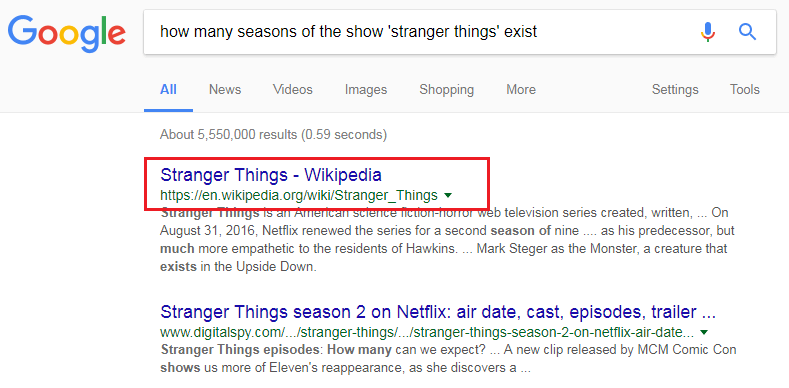
Turning towards more long-form answers, opportunities to optimize for these queries still exist – but it becomes more difficult.
For example, answers to questions like ‘How do I get red wine out of a rug’, turn up the top organic result:
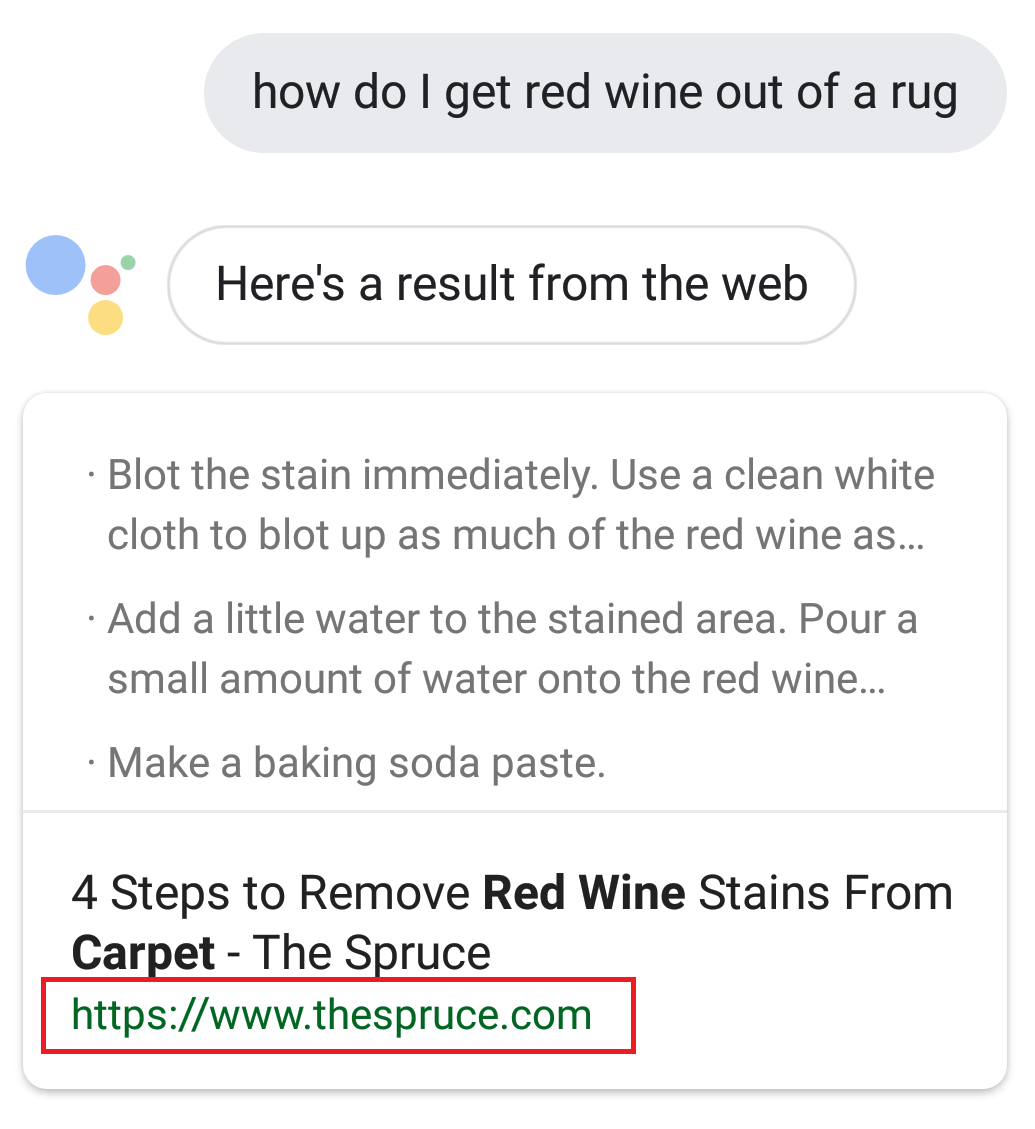 If you hope to be the chosen answer, content and links are still going to matter but equally important is to be cognizant of the fact that the way content is formatted on the page will matter, too.
If you hope to be the chosen answer, content and links are still going to matter but equally important is to be cognizant of the fact that the way content is formatted on the page will matter, too.
In this example, if we look at the code that helps to generate this answer we see a heading and an ordered list wrapped in a container. Perfectly semantic HTML and just what Google likes to see:
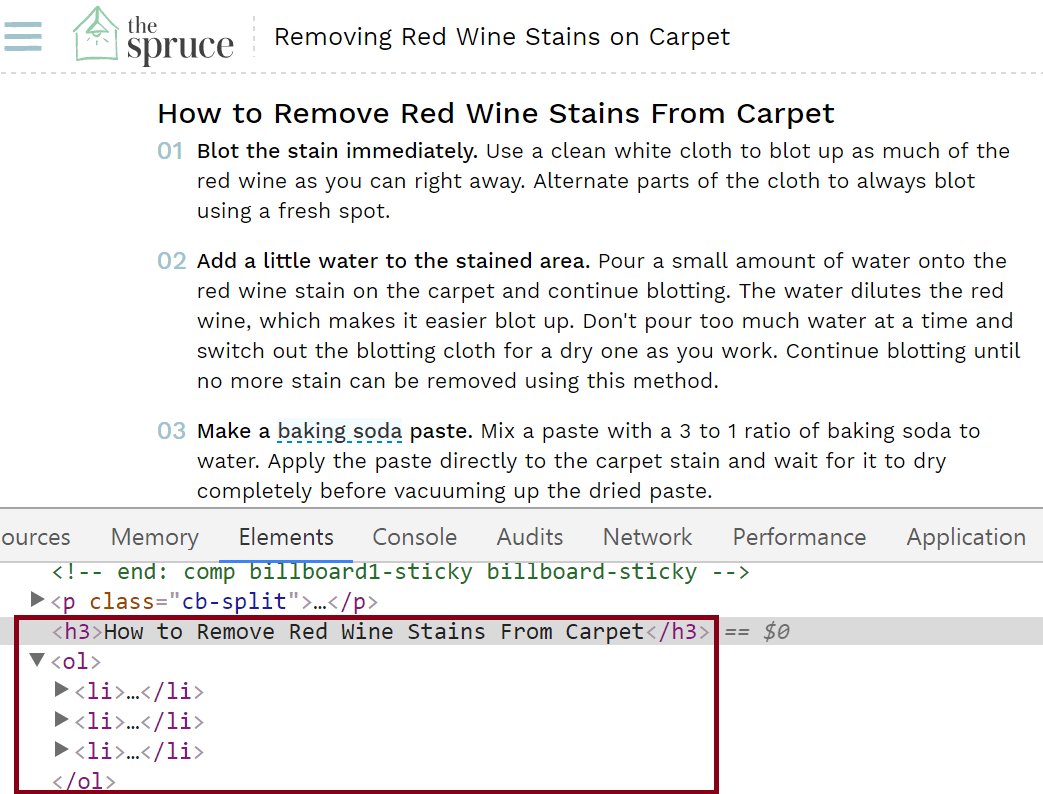
The Takeaway:
While Voice Search is gaining popularity overall, becoming the top search answer will require that:
- Your content is on the first page of Google – as we saw above, Google will pull its content from trusted sources and the most trusted sources appear at the top of the first page.
- Your web content is marked up properly which means you are using the proper HTML markup tags and other techniques like Structured Data to help Google read and understand your content.
Want more tips about optimizing for the Featured Answer? Check out the Top Local SEO Strategies in 2018 post I did that goes over this in more detail!
Tuning-In to Video
Video is another area of SEO that’s definitely worth looking at.
Consider these statistics:
- More than 500 million hours of video are consumed on YouTube each day (source)
- More video content is uploaded to the internet in 30 days than the major U.S. television networks have created in 30 years (source)
- YouTube has over a billion users, almost one-third of total internet users (source)
- and a ton more fun facts about video!
It’s clear that video is a HUGE component of the internet.
That being said, if you’re not already making video content, you could be missing out on some huge benefits.
Think about this:
YouTube is the second largest search engine in the world with more traffic than Yahoo!, Bing, AOL, and Ask combined (source). If you’re not creating video content then you’re essentially missing out on all that traffic!
What’s more, is that 55% of Google searches return a video answer (with about 80% of those results coming from YouTube).
That means that apart from being discovered on YouTube for your target keywords, you may be missing out on opportunities to appear in Google’s organic search results.
That’s a lot of search engine exposure that’s being left on the table!
In addition to the increased exposure and traffic that comes from producing video content, embedding video content on your web pages improves dwell time by 6x.
People like video so much that it is predicted that by 2020, at least 75% of web traffic will be video content:
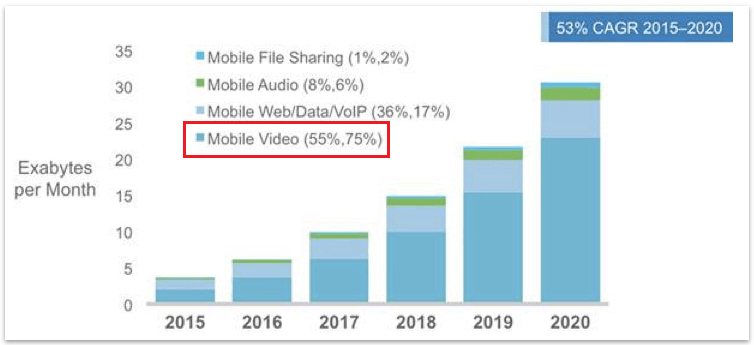
The Takeaway:
The popularity of video content is growing fast.
Those who produce video content will benefit from being on both Google and YouTube, the two largest search engines in the world.
Video also tends to have higher engagement levels and help improve search rankings overall (source).
If you’re not already making video content, now’s a great time to start!
Content and Links Still Rule
At the end of the day, none of the stuff I mentioned above is going to matter if you don’t have good content and links pointing to that content.
In fact, Google recently came out and said that links and content are their #1 and #2 top ranking factors.

If you don’t have link-worthy content, you won’t stand a chance of cracking the front page. And if you’re not on the first page of Google, you’re not going to appear for Voice search and other SERP features.
How to Create Better Content
Start by writing longer content as longer content tends to rank better:
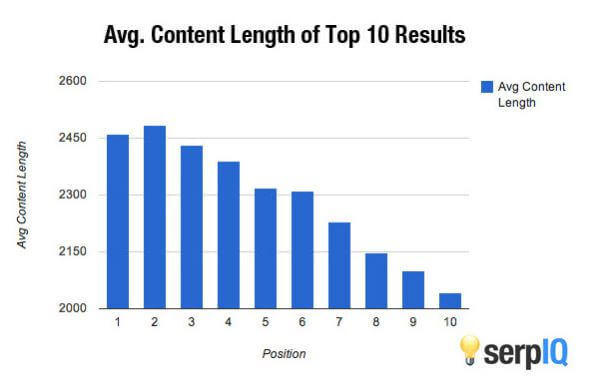
This kind of makes sense when you think about it:
Longer-form content will tend to keep people on your page for longer, thus increasing dwell time.
Additionally, longer content tends to be more link-worthy: if you can link to one, in-depth page instead of a bunch of pages that cover only a portion of a topic, why wouldn’t you?
Acquire More Links
In addition to longer content, the amount of links that point to your content is going to make a huge difference in how well you rank organically.
Consider this:
In a study by Backlinko, domains with the most links (and thereby the most domain authority) tend to outrank domains with fewer links and less authority (a bit of a no-brainer, huh?).

In laymen’s terms, a website that is linked to by a lot of people is seen as more trustworthy in the eyes of search engines like Google. As such, search engines are going to be a lot more willing to point its users to these websites.
Bottom line:
Strong content and links are still the main ranking factors when it comes to winning at SEO.
Focus on creating longer content and you’ll have a better shot at earning links naturally.
Alternatively, take a proactive approach to link-building and try to acquire links through outreach and social media networks.
However you choose to do it, links are your best friend to higher rankings, and links won’t come to you if your content stinks!
Conclusion
We now have a better idea of what’s coming down the pike for SEO in 2018.
From artificial intelligence generating our search results to Voice search and more video, to stay up to date with what’s happening online we’ll need to shift our SEO strategy to work with these trends.
Remember to:
- Become more aware of the keywords you choose to target as there’s going to be less space on Page One for organic search results.
- Focus on creating strong content and improving the user experience in order to generate positive user signals and, hopefully, more links to your content.
- Optimize your mobile site, making sure it’s quick and easy to use.
Brace yourself for a new frontier of search and SEO!
Which SEO trend is the one you’re going to optimize most for? Leave a comment below!




